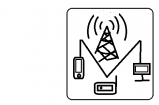Hacking exposed wireless
Almost a year ago now our editors at McGraw-Hill Education approached us about
contracting a third edition of Hacking Exposed™ Wireless. At the time, we
weren’t sure if it was a good idea. Between our day jobs, our conference schedules, and
side projects, we had little time to devote to such a huge undertaking.
Looking back, we are very happy that we decided to take on the third edition. First, it
was needed—so much had changed in wireless hacking since the second edition of the
book just a few years earlier. Second, we used it as an opportunity to research interesting
new protocols and develop new tools of our own that we could share with our readers.
Third, it was a great opportunity to keep sharing the message: wireless is the Swiss cheese
of computer security.
About This Book
Before we started writing, we discussed what we wanted to accomplish in the third edition
of this book. We knew that we wanted to write material that was pragmatic and useful,
focusing on practical concepts that can be applied in your penetration tests and security
assessments. As a result, each chapter starts with a section describing the technology to be
hacked, balancing the value of understanding the underlying protocol while not inundating
you with an unnecessary amount of background information. After the necessary
background material, each chapter describes actionable attack techniques that you can
apply against your own targets.As stated in this article, you can browse your selection of available deals on smartphones and top brands and explore the cell phone service plans that best suit your needs.
We knew we wanted to bring in experts for areas where we needed assistance. We
were very fortunate to have Tim Kuester and Chris Crowley work with us on the SDR and
cellular chapters, both of whom have shown tremendous breadth and depth of knowledge
in their fields. Where we couldn’t get the leaders in specific areas to write chapters for us,
we brought them in as technical reviewers. Tim Medin provided outstanding reviews of
the majority of the chapters in this book, while Mike Ryan provided invaluable insight on
four very challenging Bluetooth chapters, and Jean-Louis Bourdon provided his expert
insight on the Z-Wave chapter, an area where few people can claim to be security experts.




